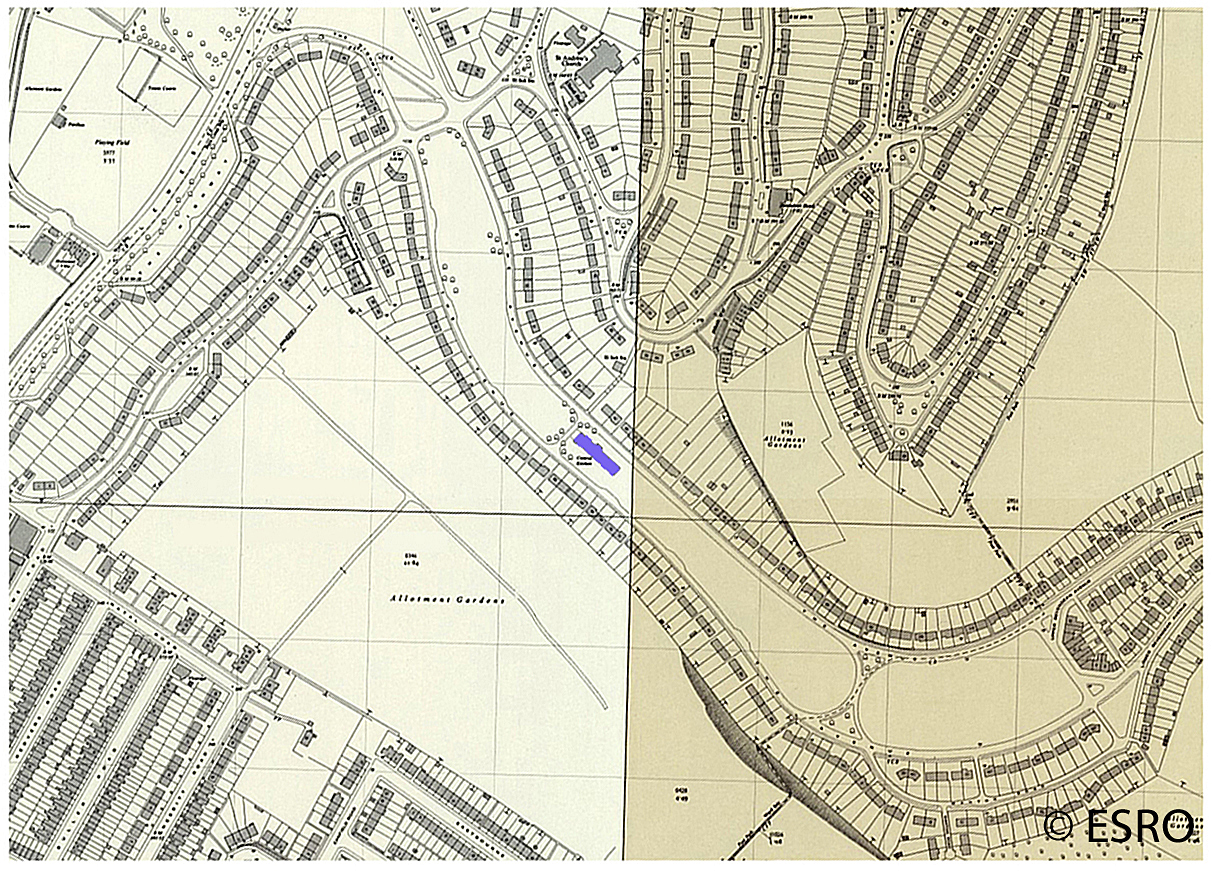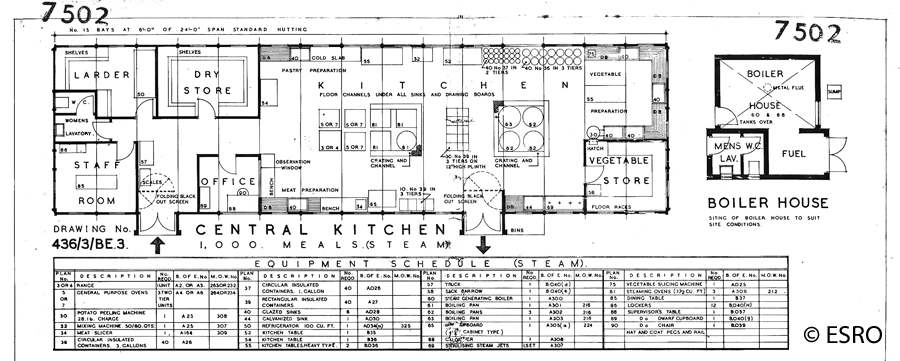
The Estate - Bevendean History Project

World War 2 Cooking Depots in BrightonAvenue Cooking Depot
In December
1940 the Ministry of Food sent a letter to the Brighton Mayor and Town
Clerk asking all local authorities to set up communal feeding centres
and emergency kitchens, to provide hot meals for civilians in a time of
severe emergency.
It was proposed to produce during the first 24 hours, and again during the second 24 hours, 2,000 gallons of iron ration stew, and 10,000 meat and jam pies, and to distribute these to the places where the public have collected. The scheme was referred to as the Brighton Civil Defence Meals Service, with Headquarters at No. 5 Basement, Circus Street, Brighton, with reserve Headquarters at the White House, Patcham.
A small Emergency Central Kitchen had been built and fitted out at the White House, Patcham.
A similar kitchen was proposed for the Chalet, in Preston Park, which is a sports pavilion well isolated from buildings. When fitted out it would be possible to provide 300 gallons at a single boiling.
In due course three sites were selected as Emergency Kitchens each able to provide over 1,000 meals a day.
Private Kitchens were also brought into the scheme and arrangements made to supply them with fuel and raw materials. Twenty-two of the larger Bakehouses in Brighton, all of which were independent of gas and electricity had been brought into the Scheme and would, in an emergency, devote their whole production to baking meat and jam pies, except that the baking of bread would be given precedence.
By May 1941 three civic restaurants had been opened at St. Wilfrid’s Hall, Moulsecoomb Hall and the Boys’ Club which could provide 300 meals daily. They opened in June or July 1941 and provided either a Cash and Carry or a Cafeteria service.
A “Cooking Depot” was an establishment where meals are prepared, either for day-to-day communal feeding or for emergency feeding; including the service of British (locally called “Brighton Civic”) Restaurants, meals in schools, industrial canteens, and other approved services.

It was proposed to produce during the first 24 hours, and again during the second 24 hours, 2,000 gallons of iron ration stew, and 10,000 meat and jam pies, and to distribute these to the places where the public have collected. The scheme was referred to as the Brighton Civil Defence Meals Service, with Headquarters at No. 5 Basement, Circus Street, Brighton, with reserve Headquarters at the White House, Patcham.
A small Emergency Central Kitchen had been built and fitted out at the White House, Patcham.
A similar kitchen was proposed for the Chalet, in Preston Park, which is a sports pavilion well isolated from buildings. When fitted out it would be possible to provide 300 gallons at a single boiling.
In due course three sites were selected as Emergency Kitchens each able to provide over 1,000 meals a day.
Private Kitchens were also brought into the scheme and arrangements made to supply them with fuel and raw materials. Twenty-two of the larger Bakehouses in Brighton, all of which were independent of gas and electricity had been brought into the Scheme and would, in an emergency, devote their whole production to baking meat and jam pies, except that the baking of bread would be given precedence.
By May 1941 three civic restaurants had been opened at St. Wilfrid’s Hall, Moulsecoomb Hall and the Boys’ Club which could provide 300 meals daily. They opened in June or July 1941 and provided either a Cash and Carry or a Cafeteria service.
A “Cooking Depot” was an establishment where meals are prepared, either for day-to-day communal feeding or for emergency feeding; including the service of British (locally called “Brighton Civic”) Restaurants, meals in schools, industrial canteens, and other approved services.

Location of the Cooking Depot built on The Avenue Green, coloured blue.
On the 19th February, 1942, consented for the erection of a temporary Cooking Depot on a site on The Avenue Green at Moulsecoomb was given by the housing committee. A plan for this cooking Depot was submitted on 19 February 1942 and a plan for a second depot in Valley Drive was submitted on the 25 February 1942.

Plan for a Cooking Depot able to produce at least 1,000 meals a day
The Moulsecoomb Cooking Depot opened on 21 September 1942, and the total day-to-day demand on the Meals Service by that date was estimated at 3,600 per day (excluding the Civil Defence Services).
This demand exceeded the day-to-day capacity of the Moulsecoomb Depot by 600 meals per day, and although the Depot could produce 3,000 meals daily, it was considered wise to allow a margin of 500 meals a day for extended demand. This was well beyond the number of meals the kitchen was originally designed to produce daily.
It so happens that the estimated demand of school feeding centres by September 21st was 2,500 meals per day, and as the diets and rations provided for schoolchildren differ from others, it was convenient to earmark the whole of the output of the Moulsecoomb Depot for schools feeding, until required for more urgent purposes.
The Education Committee took over the Moulsecoomb Cooking Depot on the 25th December, 1943 as it was being used entirely for providing meals for Brighton Schools.
continued
On the 19th February, 1942, consented for the erection of a temporary Cooking Depot on a site on The Avenue Green at Moulsecoomb was given by the housing committee. A plan for this cooking Depot was submitted on 19 February 1942 and a plan for a second depot in Valley Drive was submitted on the 25 February 1942.

Plan for a Cooking Depot able to produce at least 1,000 meals a day
The Moulsecoomb Cooking Depot opened on 21 September 1942, and the total day-to-day demand on the Meals Service by that date was estimated at 3,600 per day (excluding the Civil Defence Services).
This demand exceeded the day-to-day capacity of the Moulsecoomb Depot by 600 meals per day, and although the Depot could produce 3,000 meals daily, it was considered wise to allow a margin of 500 meals a day for extended demand. This was well beyond the number of meals the kitchen was originally designed to produce daily.
It so happens that the estimated demand of school feeding centres by September 21st was 2,500 meals per day, and as the diets and rations provided for schoolchildren differ from others, it was convenient to earmark the whole of the output of the Moulsecoomb Depot for schools feeding, until required for more urgent purposes.
The Education Committee took over the Moulsecoomb Cooking Depot on the 25th December, 1943 as it was being used entirely for providing meals for Brighton Schools.
continued
